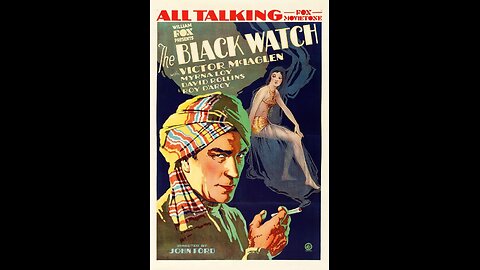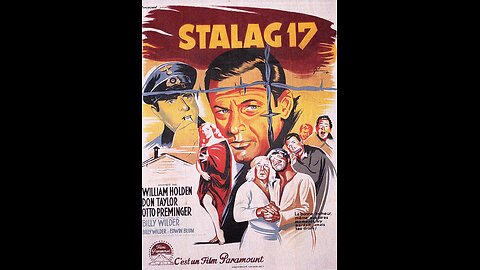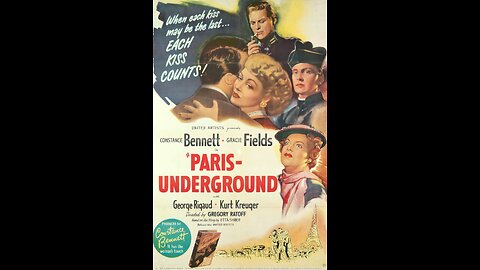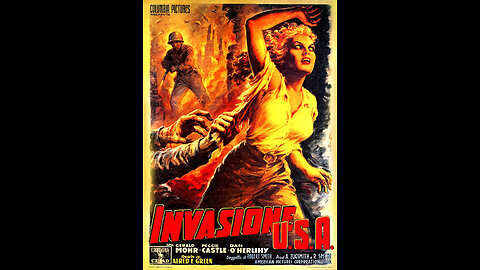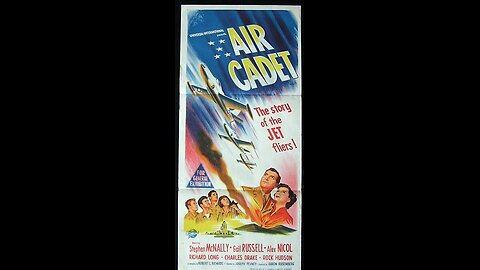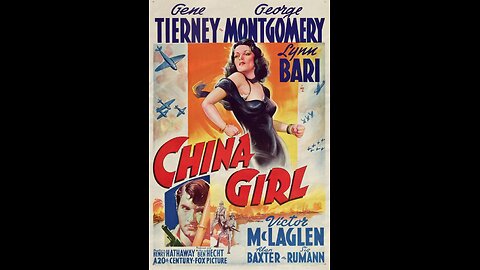
War Classics
67 videos
Updated 18 days ago
Classic War Films from the Golden Era
-
The Caine Mutiny (1954) | Directed by Edward Dmytryk
 Classic Films & Movies ArchiveThe Caine Mutiny is a World War II naval courtroom drama that explores authority, loyalty, and mental instability aboard a U.S. Navy minesweeper. When the eccentric and authoritarian Captain Queeg shows signs of mental unfitness during a crisis at sea, his executive officer relieves him of command to save the ship. This act leads to a dramatic court-martial, where the motivations and judgments of the officers involved come under intense scrutiny. The film is based on Herman Wouk’s bestselling and Pulitzer Prize-winning novel of the same name. Genre: War, Drama, Courtroom Director: Edward Dmytryk Edward Dmytryk was a Canadian-born American film director known for his sharp visual style and for directing several classic film noirs. His career was interrupted when he became one of the Hollywood Ten, a group of filmmakers who were blacklisted for refusing to testify before the House Un-American Activities Committee during the Red Scare. After serving prison time and later cooperating with the committee, Dmytryk resumed directing, and The Caine Mutiny marked a major comeback, showcasing his ability to blend character-driven drama with suspenseful storytelling. Star Cast: - Humphrey Bogart as Lt. Cmdr. Philip Francis Queeg - José Ferrer as Lt. Barney Greenwald - Van Johnson as Lt. Steve Maryk - Fred MacMurray as Lt. Tom Keefer - Robert Francis as Ensign Willis Keith - May Wynn as May Wynn - Tom Tully as Commander DeVriess The film was a critical and commercial success. Audiences and reviewers praised Humphrey Bogart's intense performance as the troubled Captain Queeg, which earned him an Academy Award nomination for Best Actor. The film itself received seven Oscar nominations, including Best Picture. It became the second-highest-grossing film in the United States in 1954. Viewers found the film’s themes of duty, courage, and psychological tension particularly compelling in the postwar era. Fun Facts: - The Caine Mutiny was Bogart’s final Oscar-nominated role and is widely considered one of his best performances. - The climactic courtroom scene, with Ferrer’s monologue, is still studied in film and legal schools for its structure and moral ambiguity. - Robert Francis, who played the young officer Keith, tragically died in a plane crash just a year later in 1955. - The film played a significant role in rehabilitating Edward Dmytryk’s Hollywood career after his blacklisting. - Though titled The Caine Mutiny, no official mutiny occurs in the legal sense, a point that is central to the courtroom drama. The Caine Mutiny remains an enduring classic, noted for its complex characters, moral dilemmas, and exploration of command responsibility in wartime. * This Rumble Movie Channel is comprehensively indexed on https://kinoquick.com - find you favourite movies fast & free! * Follow this channel to be notified of daily movie updates.235 views
Classic Films & Movies ArchiveThe Caine Mutiny is a World War II naval courtroom drama that explores authority, loyalty, and mental instability aboard a U.S. Navy minesweeper. When the eccentric and authoritarian Captain Queeg shows signs of mental unfitness during a crisis at sea, his executive officer relieves him of command to save the ship. This act leads to a dramatic court-martial, where the motivations and judgments of the officers involved come under intense scrutiny. The film is based on Herman Wouk’s bestselling and Pulitzer Prize-winning novel of the same name. Genre: War, Drama, Courtroom Director: Edward Dmytryk Edward Dmytryk was a Canadian-born American film director known for his sharp visual style and for directing several classic film noirs. His career was interrupted when he became one of the Hollywood Ten, a group of filmmakers who were blacklisted for refusing to testify before the House Un-American Activities Committee during the Red Scare. After serving prison time and later cooperating with the committee, Dmytryk resumed directing, and The Caine Mutiny marked a major comeback, showcasing his ability to blend character-driven drama with suspenseful storytelling. Star Cast: - Humphrey Bogart as Lt. Cmdr. Philip Francis Queeg - José Ferrer as Lt. Barney Greenwald - Van Johnson as Lt. Steve Maryk - Fred MacMurray as Lt. Tom Keefer - Robert Francis as Ensign Willis Keith - May Wynn as May Wynn - Tom Tully as Commander DeVriess The film was a critical and commercial success. Audiences and reviewers praised Humphrey Bogart's intense performance as the troubled Captain Queeg, which earned him an Academy Award nomination for Best Actor. The film itself received seven Oscar nominations, including Best Picture. It became the second-highest-grossing film in the United States in 1954. Viewers found the film’s themes of duty, courage, and psychological tension particularly compelling in the postwar era. Fun Facts: - The Caine Mutiny was Bogart’s final Oscar-nominated role and is widely considered one of his best performances. - The climactic courtroom scene, with Ferrer’s monologue, is still studied in film and legal schools for its structure and moral ambiguity. - Robert Francis, who played the young officer Keith, tragically died in a plane crash just a year later in 1955. - The film played a significant role in rehabilitating Edward Dmytryk’s Hollywood career after his blacklisting. - Though titled The Caine Mutiny, no official mutiny occurs in the legal sense, a point that is central to the courtroom drama. The Caine Mutiny remains an enduring classic, noted for its complex characters, moral dilemmas, and exploration of command responsibility in wartime. * This Rumble Movie Channel is comprehensively indexed on https://kinoquick.com - find you favourite movies fast & free! * Follow this channel to be notified of daily movie updates.235 views -
The Black Watch (1929) | Directed by John Ford
 Classic Films & Movies ArchiveThe Black Watch is a war adventure drama set during the early days of World War I. The story follows a British Army officer, Captain Donald King, who is assigned a secret mission in India just as his regiment, the famous Black Watch, is sent to the front lines in Europe. Though misunderstood and labelled a coward for staying behind, King undertakes a dangerous undercover operation to help thwart a tribal uprising in the British Raj. Genre: War, Adventure, Drama Director: John Ford John Ford was one of the most influential directors in American cinema history. Born in 1894, he directed over 140 films in a career spanning more than 50 years. Ford is best known for his Westerns, including Stagecoach, The Searchers, and The Man Who Shot Liberty Valance, as well as for his four Academy Awards for Best Director. Known for his visual storytelling, use of natural landscapes, and strong moral themes, Ford began directing silent films before transitioning into talkies with The Black Watch as his first sound feature. Star Cast: - Victor McLaglen as Captain Donald King - Myrna Loy as Yasmani - Francis Ford as Major MacGregor - Lumsden Hare as Colonel Gregory - David Rollins as Lieutenant Malcolm - Roy D'Arcy as Rewa Ghunga The Black Watch received mixed to positive reactions upon its release, largely because it marked John Ford's transition from silent to sound films. Victor McLaglen was praised for his performance, and audiences enjoyed the film’s exotic setting and action sequences. Critics noted the uneven pacing but appreciated the film's ambition and scope. It was an early talkie that managed to hold public interest during a time of great change in the film industry. Fun Facts: - The Black Watch was John Ford’s first sound film. - The story was based on the novel “King of the Khyber Rifles” by Talbot Mundy. - Myrna Loy, who played Yasmani, was in the early stages of her career and would later become a major Hollywood star. - Francis Ford, who played Major MacGregor, was John Ford’s older brother and appeared in many of his films. - The movie features elaborate sets and costumes depicting British India, which were considered visually impressive for the time. - It was produced by Fox Film Corporation before its merger with Twentieth Century Pictures. * This Rumble Movie Channel is comprehensively indexed on https://kinoquick.com - find you favourite movies fast & free! * Follow this channel to be notified of daily movie updates.249 views
Classic Films & Movies ArchiveThe Black Watch is a war adventure drama set during the early days of World War I. The story follows a British Army officer, Captain Donald King, who is assigned a secret mission in India just as his regiment, the famous Black Watch, is sent to the front lines in Europe. Though misunderstood and labelled a coward for staying behind, King undertakes a dangerous undercover operation to help thwart a tribal uprising in the British Raj. Genre: War, Adventure, Drama Director: John Ford John Ford was one of the most influential directors in American cinema history. Born in 1894, he directed over 140 films in a career spanning more than 50 years. Ford is best known for his Westerns, including Stagecoach, The Searchers, and The Man Who Shot Liberty Valance, as well as for his four Academy Awards for Best Director. Known for his visual storytelling, use of natural landscapes, and strong moral themes, Ford began directing silent films before transitioning into talkies with The Black Watch as his first sound feature. Star Cast: - Victor McLaglen as Captain Donald King - Myrna Loy as Yasmani - Francis Ford as Major MacGregor - Lumsden Hare as Colonel Gregory - David Rollins as Lieutenant Malcolm - Roy D'Arcy as Rewa Ghunga The Black Watch received mixed to positive reactions upon its release, largely because it marked John Ford's transition from silent to sound films. Victor McLaglen was praised for his performance, and audiences enjoyed the film’s exotic setting and action sequences. Critics noted the uneven pacing but appreciated the film's ambition and scope. It was an early talkie that managed to hold public interest during a time of great change in the film industry. Fun Facts: - The Black Watch was John Ford’s first sound film. - The story was based on the novel “King of the Khyber Rifles” by Talbot Mundy. - Myrna Loy, who played Yasmani, was in the early stages of her career and would later become a major Hollywood star. - Francis Ford, who played Major MacGregor, was John Ford’s older brother and appeared in many of his films. - The movie features elaborate sets and costumes depicting British India, which were considered visually impressive for the time. - It was produced by Fox Film Corporation before its merger with Twentieth Century Pictures. * This Rumble Movie Channel is comprehensively indexed on https://kinoquick.com - find you favourite movies fast & free! * Follow this channel to be notified of daily movie updates.249 views -
Fear and Desire (1953) | American war film directed by Stanley Kubrick
 Classic Films & Movies Archive"Fear and Desire" is a 1953 American war film directed by Stanley Kubrick, marking his feature film directorial debut. The film, although not widely known compared to Kubrick's later works, is notable for showcasing the director's early talent and experimentation. Plot: The story follows a small group of soldiers stranded behind enemy lines during an unspecified war. As they navigate through enemy territory, the soldiers grapple with fear, desire, and the brutality of war. The film delves into the psychological effects of combat on the human psyche, exploring themes of survival, morality, and the thin line between sanity and madness. Production and Style: Shot on a shoestring budget, "Fear and Desire" reflects Kubrick's innovative and resourceful filmmaking. The film exhibits early signs of Kubrick's distinctive visual style and his exploration of complex themes. While the narrative might be considered somewhat abstract, Kubrick's directorial choices and the experimental nature of the film showcase his burgeoning talent. Legacy: "Fear and Desire" is a film that has gained recognition retrospectively, primarily due to Stanley Kubrick's later prominence as a filmmaker. It serves as a valuable piece of cinematic history, offering insights into the early creative mind of one of the most influential directors in the history of cinema. While not without its flaws, the film remains an essential watch for Kubrick enthusiasts and those interested in the evolution of cinematic storytelling.285 views
Classic Films & Movies Archive"Fear and Desire" is a 1953 American war film directed by Stanley Kubrick, marking his feature film directorial debut. The film, although not widely known compared to Kubrick's later works, is notable for showcasing the director's early talent and experimentation. Plot: The story follows a small group of soldiers stranded behind enemy lines during an unspecified war. As they navigate through enemy territory, the soldiers grapple with fear, desire, and the brutality of war. The film delves into the psychological effects of combat on the human psyche, exploring themes of survival, morality, and the thin line between sanity and madness. Production and Style: Shot on a shoestring budget, "Fear and Desire" reflects Kubrick's innovative and resourceful filmmaking. The film exhibits early signs of Kubrick's distinctive visual style and his exploration of complex themes. While the narrative might be considered somewhat abstract, Kubrick's directorial choices and the experimental nature of the film showcase his burgeoning talent. Legacy: "Fear and Desire" is a film that has gained recognition retrospectively, primarily due to Stanley Kubrick's later prominence as a filmmaker. It serves as a valuable piece of cinematic history, offering insights into the early creative mind of one of the most influential directors in the history of cinema. While not without its flaws, the film remains an essential watch for Kubrick enthusiasts and those interested in the evolution of cinematic storytelling.285 views -
Stalag 17 (1953) | Directed by Billy Wilder
 Classic Films & Movies ArchiveDirector: Billy Wilder with William Holden, Don Taylor, Otto Preminger, Robert Strauss "Stalag 17" is a gripping World War II drama directed by the renowned Billy Wilder. Set in a German prisoner-of-war camp, the film follows the lives of American airmen held captive by the enemy. Tensions rise within Barracks 4 when suspicion of a spy infiltrating the group becomes a haunting reality. The focus turns to J.J. Sefton (William Holden), a cynical and opportunistic POW, as the potential traitor. The intricate plot weaves together elements of suspense, camaraderie, and wartime humor as the prisoners navigate the challenges of confinement. Holden delivers a memorable performance, earning an Academy Award for Best Actor. The film masterfully balances its serious subject matter with Wilder's signature wit, creating a timeless classic that explores the complexities of loyalty, trust, and survival in the face of adversity. "Stalag 17" remains an enduring testament to the human spirit and the bonds forged in the crucible of war.432 views
Classic Films & Movies ArchiveDirector: Billy Wilder with William Holden, Don Taylor, Otto Preminger, Robert Strauss "Stalag 17" is a gripping World War II drama directed by the renowned Billy Wilder. Set in a German prisoner-of-war camp, the film follows the lives of American airmen held captive by the enemy. Tensions rise within Barracks 4 when suspicion of a spy infiltrating the group becomes a haunting reality. The focus turns to J.J. Sefton (William Holden), a cynical and opportunistic POW, as the potential traitor. The intricate plot weaves together elements of suspense, camaraderie, and wartime humor as the prisoners navigate the challenges of confinement. Holden delivers a memorable performance, earning an Academy Award for Best Actor. The film masterfully balances its serious subject matter with Wilder's signature wit, creating a timeless classic that explores the complexities of loyalty, trust, and survival in the face of adversity. "Stalag 17" remains an enduring testament to the human spirit and the bonds forged in the crucible of war.432 views -
Paris Underground / Madame Pimpernel (1945) | American war film directed by Gregory Ratoff
 Classic Films & Movies Archive"Paris Underground" is a 1945 American war film directed by Gregory Ratoff. The film is set during World War II and is based on the true story of the French Resistance. It focuses on the efforts of the French people to resist the German occupation and assist Allied airmen who have been shot down over France. Here is a detailed description of the film: The film is set in German-occupied Paris during World War II. It follows the story of a group of individuals who become involved in the French Resistance, working to undermine the Nazi regime and aid Allied soldiers stranded in France. The central characters include Frenchwoman Kitty de Mornay (played by Constance Bennett) and American expatriate and nightclub owner Anton Randall (played by Gracie Fields). Kitty, having lost her husband in the war, is motivated to join the Resistance and fight against the Germans. Anton, though initially reluctant to get involved, eventually joins the cause. The Resistance group becomes particularly focused on helping downed Allied airmen evade capture and return safely to England. They establish an underground network to hide and guide these airmen through the dangerous streets of Paris. As the group carries out their covert activities, they face numerous challenges and dangers, including the constant threat of discovery by the occupying German forces. Tensions rise, and the characters find themselves in situations that test their courage and commitment to the cause. The film also explores the relationships that develop among the characters, depicting the bonds formed under the stressful circumstances of war. The themes of sacrifice, bravery, and the fight for freedom are prevalent throughout the narrative. "Paris Underground" is known for its portrayal of the French Resistance and the courageous individuals who risked their lives to defy the German occupation. The film captures the spirit of resistance movements during World War II and the collaborative efforts of people from different backgrounds coming together for a common cause. While the film may not be as widely remembered as some other war classics, it remains a notable entry in the wartime cinema of the 1940s. Its depiction of ordinary people making extraordinary sacrifices contributes to its historical and cultural significance.119 views
Classic Films & Movies Archive"Paris Underground" is a 1945 American war film directed by Gregory Ratoff. The film is set during World War II and is based on the true story of the French Resistance. It focuses on the efforts of the French people to resist the German occupation and assist Allied airmen who have been shot down over France. Here is a detailed description of the film: The film is set in German-occupied Paris during World War II. It follows the story of a group of individuals who become involved in the French Resistance, working to undermine the Nazi regime and aid Allied soldiers stranded in France. The central characters include Frenchwoman Kitty de Mornay (played by Constance Bennett) and American expatriate and nightclub owner Anton Randall (played by Gracie Fields). Kitty, having lost her husband in the war, is motivated to join the Resistance and fight against the Germans. Anton, though initially reluctant to get involved, eventually joins the cause. The Resistance group becomes particularly focused on helping downed Allied airmen evade capture and return safely to England. They establish an underground network to hide and guide these airmen through the dangerous streets of Paris. As the group carries out their covert activities, they face numerous challenges and dangers, including the constant threat of discovery by the occupying German forces. Tensions rise, and the characters find themselves in situations that test their courage and commitment to the cause. The film also explores the relationships that develop among the characters, depicting the bonds formed under the stressful circumstances of war. The themes of sacrifice, bravery, and the fight for freedom are prevalent throughout the narrative. "Paris Underground" is known for its portrayal of the French Resistance and the courageous individuals who risked their lives to defy the German occupation. The film captures the spirit of resistance movements during World War II and the collaborative efforts of people from different backgrounds coming together for a common cause. While the film may not be as widely remembered as some other war classics, it remains a notable entry in the wartime cinema of the 1940s. Its depiction of ordinary people making extraordinary sacrifices contributes to its historical and cultural significance.119 views -
Invasion, U.S.A. (1952) | American Cold War-era film directed by Alfred E. Green
 Classic Films & Movies Archive"Invasion, U.S.A." is a 1952 American Cold War-era film directed by Alfred E. Green. The film is a drama with elements of political thriller and war propaganda, typical of its time. The film opens with news reports about a potential invasion of the United States by an unnamed foreign enemy. The narrative then transitions to the bustling city of New York, where people go about their daily lives, unaware of the imminent threat. The central character is Vince Potter (played by Gerald Mohr), a former war correspondent and current radio broadcaster. Vince is visited by a mysterious man named Mr. Ohman (played by Dan O'Herlihy), who reveals that enemy forces are planning a full-scale invasion of the United States. The invaders are depicted as a coalition of communist nations, capitalizing on the Cold War fears prevalent during the early 1950s. Vince becomes determined to warn the American public and rally them against the impending invasion. He uses his radio show to convey the urgency of the situation, urging citizens to be vigilant and prepare for the enemy attack. The film portrays a stark and alarming vision of the potential consequences of a successful invasion, with scenes depicting the occupation of American cities, the suppression of civil liberties, and the imposition of a foreign regime. The narrative unfolds as a series of vignettes, showcasing how different individuals and communities react to the news of the invasion. The film employs a documentary-style approach, interweaving fictional events with newsreel footage to create a sense of immediacy. "Invasion, U.S.A." reflects the political climate of the early 1950s, marked by the Red Scare and heightened tensions between the United States and the Soviet Union. The film serves as a piece of anti-communist propaganda, emphasizing the need for unity and vigilance to protect American democracy. Gerald Mohr (Vince Potter): Mohr delivers a strong performance as the protagonist, embodying the urgency and determination of his character. Dan O'Herlihy (Mr. Ohman): O'Herlihy portrays the mysterious informant, adding an enigmatic and ominous quality to the narrative. While "Invasion, U.S.A." is not considered a cinematic masterpiece, it is notable for its representation of Cold War paranoia and its use of propaganda elements. The film captures the fears and anxieties of its time, reflecting the broader cultural and political context of the early 1950s in the United States. It stands as a historical artifact, offering insights into the mindset of the era and the ways in which film was used to convey political messages.352 views
Classic Films & Movies Archive"Invasion, U.S.A." is a 1952 American Cold War-era film directed by Alfred E. Green. The film is a drama with elements of political thriller and war propaganda, typical of its time. The film opens with news reports about a potential invasion of the United States by an unnamed foreign enemy. The narrative then transitions to the bustling city of New York, where people go about their daily lives, unaware of the imminent threat. The central character is Vince Potter (played by Gerald Mohr), a former war correspondent and current radio broadcaster. Vince is visited by a mysterious man named Mr. Ohman (played by Dan O'Herlihy), who reveals that enemy forces are planning a full-scale invasion of the United States. The invaders are depicted as a coalition of communist nations, capitalizing on the Cold War fears prevalent during the early 1950s. Vince becomes determined to warn the American public and rally them against the impending invasion. He uses his radio show to convey the urgency of the situation, urging citizens to be vigilant and prepare for the enemy attack. The film portrays a stark and alarming vision of the potential consequences of a successful invasion, with scenes depicting the occupation of American cities, the suppression of civil liberties, and the imposition of a foreign regime. The narrative unfolds as a series of vignettes, showcasing how different individuals and communities react to the news of the invasion. The film employs a documentary-style approach, interweaving fictional events with newsreel footage to create a sense of immediacy. "Invasion, U.S.A." reflects the political climate of the early 1950s, marked by the Red Scare and heightened tensions between the United States and the Soviet Union. The film serves as a piece of anti-communist propaganda, emphasizing the need for unity and vigilance to protect American democracy. Gerald Mohr (Vince Potter): Mohr delivers a strong performance as the protagonist, embodying the urgency and determination of his character. Dan O'Herlihy (Mr. Ohman): O'Herlihy portrays the mysterious informant, adding an enigmatic and ominous quality to the narrative. While "Invasion, U.S.A." is not considered a cinematic masterpiece, it is notable for its representation of Cold War paranoia and its use of propaganda elements. The film captures the fears and anxieties of its time, reflecting the broader cultural and political context of the early 1950s in the United States. It stands as a historical artifact, offering insights into the mindset of the era and the ways in which film was used to convey political messages.352 views -
Air Cadet (1951) | American war film directed by Joseph Pevney & starring Rock Hudson
 Classic Films & Movies Archive"Air Cadet" is a 1951 American war film directed by Joseph Pevney and starring Rock Hudson. Set against the backdrop of the United States Air Force, the film follows the experiences of young men training to become pilots during the early 1950s. The story revolves around a group of aspiring cadets as they undergo rigorous training at an air force academy. Rock Hudson's character takes center stage as he navigates the challenges, friendships, and rivalries within the cadet program. As the cadets progress through their training, the film explores themes of discipline, camaraderie, and the dedication required to become a skilled pilot. "Air Cadet" combines elements of drama and romance with the military training narrative. It provides a glimpse into the lives of those who aspire to serve in the U.S. Air Force, emphasizing the personal growth and sacrifices inherent in such a career path. The film is notable for its portrayal of the training process and the dedication required to excel in the challenging field of aviation.82 views
Classic Films & Movies Archive"Air Cadet" is a 1951 American war film directed by Joseph Pevney and starring Rock Hudson. Set against the backdrop of the United States Air Force, the film follows the experiences of young men training to become pilots during the early 1950s. The story revolves around a group of aspiring cadets as they undergo rigorous training at an air force academy. Rock Hudson's character takes center stage as he navigates the challenges, friendships, and rivalries within the cadet program. As the cadets progress through their training, the film explores themes of discipline, camaraderie, and the dedication required to become a skilled pilot. "Air Cadet" combines elements of drama and romance with the military training narrative. It provides a glimpse into the lives of those who aspire to serve in the U.S. Air Force, emphasizing the personal growth and sacrifices inherent in such a career path. The film is notable for its portrayal of the training process and the dedication required to excel in the challenging field of aviation.82 views -
China Girl (1942) | War film directed by Henry Hathaway
 Classic Films & Movies Archive"China Girl" is a 1942 war film directed by Henry Hathaway. It's important to note that this film is distinct from another film titled "China Girl" released in 1939. The 1942 version is set against the backdrop of World War II and follows a group of journalists covering the conflict in China. The film begins in war-torn China during the early days of World War II. American war correspondent Johnny Williams (played by George Montgomery) and his British counterpart, Carolyn Grant (played by Gene Tierney), find themselves caught in the midst of the Japanese invasion of China. The journalists are dedicated to reporting on the war and its impact on the Chinese people. Amid the chaos of the conflict, a romance develops between Johnny and Carolyn. Their love story unfolds against the backdrop of the larger war narrative, with the couple navigating the challenges and dangers of reporting from the front lines. As the Japanese forces advance, the journalists must balance their professional duty with their personal feelings. The film also delves into the broader issues of the war, including the resilience of the Chinese people and their struggle against the invading forces. The Chinese resistance becomes a significant aspect of the storyline, portraying the heroism and sacrifices made by the local population. "China Girl" explores themes of love, duty, and the impact of war on individuals. The characters grapple with the harsh realities of the conflict, and the film combines elements of romance and drama to tell a compelling wartime narrative. George Montgomery (Johnny Williams): Montgomery brings a mix of charm and sincerity to the role of the American war correspondent. Gene Tierney (Carolyn Grant): Tierney delivers a strong performance as the British journalist, portraying both the professional and personal dimensions of her character. "China Girl" is recognized as a wartime drama that blends romance with the harsh realities of conflict. While it may not be as well-known as some other war films of the era, the movie contributes to the cinematic portrayal of World War II and the experiences of journalists reporting from the front lines. The film's focus on the Chinese perspective during the war adds a unique element to its storytelling.132 views
Classic Films & Movies Archive"China Girl" is a 1942 war film directed by Henry Hathaway. It's important to note that this film is distinct from another film titled "China Girl" released in 1939. The 1942 version is set against the backdrop of World War II and follows a group of journalists covering the conflict in China. The film begins in war-torn China during the early days of World War II. American war correspondent Johnny Williams (played by George Montgomery) and his British counterpart, Carolyn Grant (played by Gene Tierney), find themselves caught in the midst of the Japanese invasion of China. The journalists are dedicated to reporting on the war and its impact on the Chinese people. Amid the chaos of the conflict, a romance develops between Johnny and Carolyn. Their love story unfolds against the backdrop of the larger war narrative, with the couple navigating the challenges and dangers of reporting from the front lines. As the Japanese forces advance, the journalists must balance their professional duty with their personal feelings. The film also delves into the broader issues of the war, including the resilience of the Chinese people and their struggle against the invading forces. The Chinese resistance becomes a significant aspect of the storyline, portraying the heroism and sacrifices made by the local population. "China Girl" explores themes of love, duty, and the impact of war on individuals. The characters grapple with the harsh realities of the conflict, and the film combines elements of romance and drama to tell a compelling wartime narrative. George Montgomery (Johnny Williams): Montgomery brings a mix of charm and sincerity to the role of the American war correspondent. Gene Tierney (Carolyn Grant): Tierney delivers a strong performance as the British journalist, portraying both the professional and personal dimensions of her character. "China Girl" is recognized as a wartime drama that blends romance with the harsh realities of conflict. While it may not be as well-known as some other war films of the era, the movie contributes to the cinematic portrayal of World War II and the experiences of journalists reporting from the front lines. The film's focus on the Chinese perspective during the war adds a unique element to its storytelling.132 views -
Submarine Base (1943) | A war film directed by Albert H. Kelley
 Classic Films & Movies Archive"Submarine Base" is a 1943 war film directed by Albert H. Kelley. Set against the backdrop of World War II, the film unfolds in a U.S. naval base where submarine crews are undergoing intense training for their crucial missions in the battle against enemy forces. The storyline follows the experiences of the submarine crews as they prepare for combat. The film provides insights into the challenges faced by the sailors, both in terms of the rigorous tPlease give a description for the film : Submarineraining they undergo and the emotional strain of being away from their loved ones. As the tension of war looms, the characters in "Submarine Base" must confront not only the physical demands of their roles but also the personal sacrifices required for the greater good. The film captures the camaraderie among the crew members, the technical aspects of submarine operations, and the patriotic fervor of the wartime narrative. Against the backdrop of heightened global conflict, "Submarine Base" reflects the spirit of unity and dedication prevalent during World War II. The film serves as both entertainment and a tribute to the bravery of the men serving in the submarine service, highlighting their contributions to the war effort. While "Submarine Base" may not be as widely remembered as some other war films of its time, it remains a part of the cinematic legacy that sought to depict the valor and challenges faced by military personnel during a critical period in history.124 views
Classic Films & Movies Archive"Submarine Base" is a 1943 war film directed by Albert H. Kelley. Set against the backdrop of World War II, the film unfolds in a U.S. naval base where submarine crews are undergoing intense training for their crucial missions in the battle against enemy forces. The storyline follows the experiences of the submarine crews as they prepare for combat. The film provides insights into the challenges faced by the sailors, both in terms of the rigorous tPlease give a description for the film : Submarineraining they undergo and the emotional strain of being away from their loved ones. As the tension of war looms, the characters in "Submarine Base" must confront not only the physical demands of their roles but also the personal sacrifices required for the greater good. The film captures the camaraderie among the crew members, the technical aspects of submarine operations, and the patriotic fervor of the wartime narrative. Against the backdrop of heightened global conflict, "Submarine Base" reflects the spirit of unity and dedication prevalent during World War II. The film serves as both entertainment and a tribute to the bravery of the men serving in the submarine service, highlighting their contributions to the war effort. While "Submarine Base" may not be as widely remembered as some other war films of its time, it remains a part of the cinematic legacy that sought to depict the valor and challenges faced by military personnel during a critical period in history.124 views -
The Desert Fox: The Story of Rommel (1951) | Biographical war film directed by Henry Hathaway
 Classic Films & Movies Archive"The Desert Fox: The Story of Rommel" is a 1951 biographical war film directed by Henry Hathaway. The film chronicles the life of German Field Marshal Erwin Rommel, played by James Mason, during World War II. Rommel, known as the "Desert Fox," gained fame for his tactical brilliance as a commander in the Afrika Korps during the North African campaign. The narrative unfolds as a retrospective, with Rommel dictating his memoirs while in British custody after the defeat of the Axis forces in North Africa. Through a series of flashbacks, the film explores Rommel's rise in the military ranks, his strategic acumen, and his complex relationship with Adolf Hitler. James Mason delivers a compelling performance as Rommel, capturing the military leader's charisma, loyalty to his soldiers, and conflicts with the Nazi regime. The Desert Fox portrays Rommel as a skilled tactician who adhered to a strong sense of honor and duty, even as he found himself increasingly at odds with Hitler's decisions. The film provides a balanced portrayal of Rommel, acknowledging his military prowess while depicting the moral and ethical dilemmas he faced within the context of Nazi Germany. The Desert Fox is not just a war film but also a character study that delves into the complexities of leadership and the personal toll of war. Released in the early 1950s, "The Desert Fox" reflects the post-war period's interest in exploring the human dimensions of historical figures, adding depth to the portrayal of military leaders beyond their wartime achievements. The film contributes to the cinematic representation of World War II and remains a notable entry in the biographical war film genre.126 views
Classic Films & Movies Archive"The Desert Fox: The Story of Rommel" is a 1951 biographical war film directed by Henry Hathaway. The film chronicles the life of German Field Marshal Erwin Rommel, played by James Mason, during World War II. Rommel, known as the "Desert Fox," gained fame for his tactical brilliance as a commander in the Afrika Korps during the North African campaign. The narrative unfolds as a retrospective, with Rommel dictating his memoirs while in British custody after the defeat of the Axis forces in North Africa. Through a series of flashbacks, the film explores Rommel's rise in the military ranks, his strategic acumen, and his complex relationship with Adolf Hitler. James Mason delivers a compelling performance as Rommel, capturing the military leader's charisma, loyalty to his soldiers, and conflicts with the Nazi regime. The Desert Fox portrays Rommel as a skilled tactician who adhered to a strong sense of honor and duty, even as he found himself increasingly at odds with Hitler's decisions. The film provides a balanced portrayal of Rommel, acknowledging his military prowess while depicting the moral and ethical dilemmas he faced within the context of Nazi Germany. The Desert Fox is not just a war film but also a character study that delves into the complexities of leadership and the personal toll of war. Released in the early 1950s, "The Desert Fox" reflects the post-war period's interest in exploring the human dimensions of historical figures, adding depth to the portrayal of military leaders beyond their wartime achievements. The film contributes to the cinematic representation of World War II and remains a notable entry in the biographical war film genre.126 views
